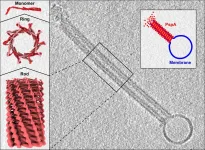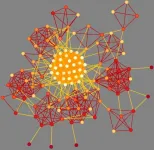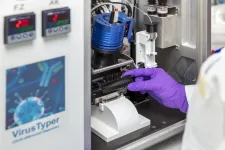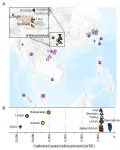Membrane proteins of bacteria and humans show surprising similarities
Research cooperation uncovers structure and function of PspA and discovers evolutionary link of a bacterial protein to human ESCRT-III proteins
2021-06-24
(Press-News.org) The cells of simple organisms, such as bacteria, as well as human cells are surrounded by a membrane, which fulfills various tasks including protecting the cell from stress. In a joint project, teams from Johannes Gutenberg University Mainz (JGU) and Forschungszentrum Jülich, with participation of Heinrich Heine University Düsseldorf (HHU), have now discovered that a membrane protein found in bacteria has a similar structure and function as a group of proteins that are responsible for remodeling and rebuilding the cell membrane in humans. No connection between the two protein groups was known before. The team's research work has been published recently in the renowned journal Cell.
PspA plays a key role in bacterial stress response
The phage shock protein (Psp) system was discovered in bacteria approximately 30 years ago. At the time, it was identified to be a response of Escherichia coli bacteria to infection with special viruses called bacteriophages. Later it became clear that its function in protecting the cell membrane exceeds the specific response to bacteriophage infection. Osmotic stress, heat, cell toxins, or defects in the membrane envelope can also trigger the stress reaction.
"Today, we know that the Psp system is activated in response to numerous types of membrane stress. However, several molecular details still remain puzzling," explained Professor Dirk Schneider, head of the Membrane Proteins group at JGU. "That's why we decided to take a closer look at core proteins of the Psp system." Together with his team, he has recently discovered how the Psp representative IM30 forms a protective carpet-like structure on a cell membrane in order to cope with membrane stress.
In their new work, the scientists scrutinized the phage shock protein A (PspA), which has a key role in the Psp system. Specifically, by using cryo-electron microscopy, it became visible how PspA forms long, spiral-shaped tubes that can enclose a biomembrane in the inner cavity. The high-resolution images now show for the very first time how PspA dissolves individual membranes locally and then reshapes them into larger units or even mediates the formation of new membrane structures.
"Thousands of PspA building blocks can be assembled to form large helical structures. Therefore, they are an ideal research object for our cryo-electron microscopic structural analysis," said Professor Carsten Sachse from Forschungszentrum Jülich and HHU Düsseldorf. The studies were performed at Jülich together with Dr. Benedikt Junglas, a former doctoral student of Professor Dirk Schneider at JGU. At the Ernst Ruska-Centre for Microscopy and Spectroscopy with Electrons (ER-C), Forschungszentrum Jülich operates some of the most powerful electron microscopes in Europe and, as of recently, cryo-microscopes for the study of flash-frozen biological samples.
PspA remodels membranes
Under the microscope, the researchers were able to recognize or - in jargon - "resolve" the structure of PspA. The structure of a protein is essential for its function and a defect in the structure can impair the protein function. "Under the microscope, we realized that PspA has a structure similar to ESCRT-III proteins, which our laboratory had already been working on. This came as a complete surprise and showed how important it is to elucidate protein structures in detail," said Sachse. "After billions of years, the two groups of proteins have genetically diverged so far that their similarities could only be detected based on their structure."
ESCRT-III proteins are found in all living organisms with a true cell nucleus, including human cells. Here, the ESCRT-III protein complexes are involved in cell membrane remodeling and repair but also play a key role in a number of other cell processes. In bacteria, no proteins of the ESCRT-III family were previously known. "Therefore, PspA and ESCRT-III belong to the same group of proteins. These two perform similar tasks at membranes inside of cells," said Schneider.
"Based on the similar structural and functional properties of PspA and the eukaryotic ESCRT-III proteins, we have identified PspA as a bacterial member of the evolutionarily conserved ESCRT-III superfamily of membrane remodeling proteins," the authors wrote in their article for Cell.
INFORMATION:
Related links:
https://www.blogs.uni-mainz.de/fb09-schneider/ - Membrane Proteins group at the JGU Department of Chemistry ;
https://www.fz-juelich.de/portal/EN/ - Forschungszentrum Jülich ;
http://www.fz-juelich.de/er-c/er-c-3 - Structural Biology (ER-C-3) group at the Ernst Ruska-Centre for Microscopy and Spectroscopy with Electrons at Forschungszentrum Jülich ;
https://www.mpgc-mainz.de/ - Max Planck Graduate Center with Johannes Gutenberg University Mainz
Read more:
https://www.uni-mainz.de/presse/aktuell/12377_ENG_HTML.php - press release "Protective shield: A membrane-attached protein protects bacteria and chloroplasts from stress" (23 Oct. 2020) ;
https://fz-juelich.de/SharedDocs/Pressemitteilungen/UK/EN/2020/notifications/2020-08-19-cryo-electron-microscopy.html - Forschungszentrum Jülich: "Cryo-Electron Microscopy Makes Structure of Important Membrane-deforming Proteins Visible" (19 Aug. 2020) ;
https://www.uni-mainz.de/presse/18298_ENG_HTML.php - press release "Fusion protein controls design of photosynthesis platform" (13 May 2015)
[Attachments] See images for this press release:

ELSE PRESS RELEASES FROM THIS DATE:
2021-06-24
Boston - In recent years, cancer immunotherapy has been effective in treating patients with immunogenic, or so-called "hot" tumors with increased levels of inflammation and the presence of immune cells in and around the tumors. Prostate cancer, however, is considered a "cold" tumor, with few immune cells recognizing and infiltrating prostate malignancies. Accordingly, prostate cancer has been found to respond poorly to the class of immunotherapies known as immune checkpoint inhibitors.
In previous work, a team led by medical oncologists at Beth Israel Deaconess Medical Center (BIDMC) identified a subset of prostate cancers that exhibited ...
2021-06-24
Cosmic dawn, when stars formed for the first time, occurred 250 million to 350 million years after the beginning of the universe, according to a new study led by researchers at University College London (UCL) and the University of Cambridge.
The study, published in the Monthly Notices of the Royal Astronomical Society, suggests that the NASA James Webb Space Telescope (JWST), scheduled to launch in November, will be sensitive enough to observe the birth of galaxies directly.
The UK-led research team examined six of the most distant galaxies currently known, whose light has taken most of the universe's ...
2021-06-24
Researchers at the Niels Bohr Institute, University of Copenhagen, together with epidemiologist Lone Simonsen from Roskilde University form part of the panel advising the Danish government on how to tackle the different infection-spreading situations we have all seen unfold over the past year. Researchers have modelled the spread of infections under a variety of scenarios, and the Coronavirus has proven to not follow the older models of disease spreading. An increasingly varied picture of its behaviour and thus its impact on society has emerged. In several scientific articles, researchers ...
2021-06-24
During the continued progression of the Corona pandemic, rapid, inexpensive, and reliable tests will become increasingly important to determine whether people have the associated antibodies - either through infection or vaccination. Researchers at the Technical University of Munich (TUM) have now developed such a rapid antibody test. It provides the result in only eight minutes; the aim is to further reduce the process time to four minutes.
There are currently more than 20 different test procedures available for determining whether a person has antibodies against the new Corona virus. The waiting times for the results range between ten minutes and two and a half hours.
Matrix effects reduce the sensitivity of many of the methods. The more sensitive assays require numerous steps, ...
2021-06-24
While invasive zebra mussels consume small plant-like organisms called phytoplankton, Michigan State University researchers discovered during a long-term study that zebra mussels can actually increase Microcystis, a type of phytoplankton known as "blue-green algae" or cyanobacteria, that forms harmful floating blooms.
"Microcystis literally means small cell, but numerous cells cluster together in colonies that can float to the surface to form scums," said Orlando Sarnelle, a professor emeritus with the Department of Fisheries and Wildlife within the College of Agriculture and Natural Resources. "It is one of the most common causes of nuisance algal blooms in nutrient-enriched waters, including Lake ...
2021-06-24
When it comes to career aspirations for teenagers, a University of Houston psychology researcher believes it's best to shoot for the moon, so you can at least land in the stars. The truth is the moon may sometimes be unreachable.
In the Journal of Career Assessment, Kevin Hoff, assistant professor of psychology, reports the existence of important discrepancies between young people's dream jobs and employment realities.
"Almost 50% of adolescents aspired to investigative or artistic careers, which together account for only 8% of the U.S. labor market," reports Hoff, whose research examined the career aspirations of 3,367 adolescents (age 13-18 years) from 42 U.S. states. Investigative jobs include those in the field of science and research.
Hoff's team ...
2021-06-24
FORT LAUDERDALE/DAVIE, Fla. - We know that the domestic cat has distant relatives that roam the earth - lions, tigers, cheetahs and mountain lions. Less familiar are the 38 distinct species in the Family Felidae, many with strange names like pampas cat, kodkod and rusty spotted cat. The new field of genomics - the unravelling of DNA genomes of separate species - is resolving old conundrums and revealing new secrets across the history of evolutionarily related species among cats, dogs, bears and ourselves.
In the largest-ever study undertaken of Chinese cats, genetic detectives highlight the evolutionary uniqueness and premier conservation importance of the elusive Chinese mountain cat (Felis silvestris bieti), found only in the Tibetan ...
2021-06-24
A joint research team led by Prof. FU Qiaomei from the Institute of Vertebrate Paleontology and Paleoanthropology (IVPP) of the Chinese Academy of Sciences sequenced the ancient genomes of 31 individuals from southern East Asia, thus unveiling a missing piece of human prehistory.
The study was published in Cell on June 24.
Prof. FU's team used DNA capture techniques to retrieve ancient DNA from Guangxi and Fujian, two provincial-level regions in southern China. They sequenced genome-wide DNA from 31 individuals dating back 11,747 to 194 years ago. Of these, two date back to more than 10,000 years ago, making them the oldest ...
2021-06-24
This worm that lives in the White Sea is able to restore lost body segments. However, it turned out that suppression of FGF protein activity disturbs this ability. Similar proteins are found in humans. This discovery may lead to developing methods of fast wound healing. The research findings are published in the journal Genes as part of the project supported by the Russian Science Foundation.
Fibroblast growth factors (FGF) are proteins that play an important role in wound healing and tissue growth. When the need for regeneration of damaged body parts occur, FGFs are produced by epidermis, nervous tissue, macrophages and fibroblasts, which are the main cells of connective tissue. As a result, ...
2021-06-24
Adolescent marijuana use and binge drinking did not significantly change during the COVID-19 pandemic, despite record decreases in the substances' perceived availability, according to a survey of 12th graders in the United States. The study's findings, which appeared online on June 24, 2021, in Drug and Alcohol Dependence, challenge the idea that reducing adolescent use of drugs can be achieved solely by limiting their supply. The work was led by researchers at the University of Michigan, Ann Arbor, and funded by the National Institute on Drug Abuse (NIDA), part of the National Institutes of Health.
In contrast to consistent rates of marijuana and alcohol use, nicotine vaping in high school seniors ...
LAST 30 PRESS RELEASES:
[Press-News.org] Membrane proteins of bacteria and humans show surprising similarities
Research cooperation uncovers structure and function of PspA and discovers evolutionary link of a bacterial protein to human ESCRT-III proteins





